There is a potential on the cell membrane. It might be seen hard to imagine.
Before talking about the potential
About cell membrane |
The actual cell membrane thickness varies depending on the constituents, but the maximum is about 10 nm (nanometer) and the minimum is about 3 nm. The unit of nanometer is 10 -9 m, which means that 10 nm is one hundred millionth of a meter, and 100,000th of a millimeter. There are various cell sizes, but if the diameter is 100 μm, the thickness is 1/10,000 of that.
Then,what is the potential difference inside and outside the cell? The answer is 70 mV .
When grounded outside the cell, the inside of the cell has a negative potential.
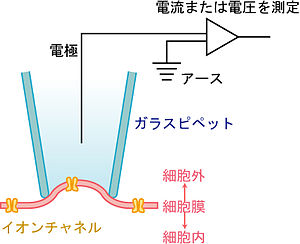
This method is?called?the?patch clamp method?.
The current flowing from the channel surrounded by the glass tube electrode is measured here, but it is possible to measure the current flowing through the entire cell by breaking the cell membrane separating the inside of the glass tube from the inside of the cell.?Illustration quoted from Wikipedea
The height of the battery is about 6 cm and the voltage is 1.5V.?Calculating how much voltage is generated when the cell membrane thickness of 10 nm is expanded to this 6 cm height, the voltage becomes 300,000 times 1.5 million.?With a cell membrane with a thickness of 3 nm, it is about 900,000 times.?This much of voltage exists in our body.
What exactly is such a cell membrane??A person weighing 60 kg has an estimated 40-60 trillion cells, and there is a cell membrane around all the cells.Not only nerve cells or muscle cells, but all cells?have different?ion?compositions?inside and outside the cell across the cell membrane, and?the difference in distribution of?charged?ions causes a difference in electric potential.?It is also present in unicellular organisms and plant cells. It is common to all living things.
The story goes in an extreme direction, but when did the cells with the membrane appear on the earth? It seems that creatures were born 4.4 to 3.9 billion years ago, assuming that the age of the earth is about 4.5 billion years.

unit is one hundred million years
http://www2.tba.t-com.ne.jp/nakada/takashi/origlife/index.html
Quoted from Kimagure Biology
There are many substances related to cell; phosphoric acid and fatty acids?(phospholipids)?that make up the cell membrane?, the?amino?acids?that are the source of?proteins,?and the?nucleic acids and bases that are the sources of DNA and RNA.
How were these made? These substances exist in outer space, meteorites, asteroids, seawater of the earth, hydrothermal vents of the deep sea, etc. Also, it seems that these substances were created due to the interplay of various environments.
In the Hadean eon, a violent collision of celestial bodies occurred on the earth, exposed to seawater, and produced many substances. Based on this, organisms with cell membranes were born.
Long story is short, and the?first life forms?seem to be classified into three types:?archaebacteria, eubacteria (currently called bacteria), and eukaryotes.
The type is sometimes divided into two; prokaryotes combined from varchaea and eubacteria (currently called bacteria) , and eukaryotes.
A characteristic of prokaryotes is that they have no nucleus.?Eukaryotes have a nucleus.?
| From a current medical point of view, the source of infection is eubacteria, and archaea are not pathogenic |
Eukaryotes and eubacteria tend to have fatty acid esters of sn - glycerol 3-phosphate .
Archaea have an ether bond, and eukaryotes and eubacteria have an ester bond to form the cell membrane. The structural differences of the cell membrane are shown below.Archaea has lipids.
The upper and lower circles are poked out the extracellular and internal parts. As I will explain in detail later, this part is called hydrophilic and has a structure compatible with water.
Eubacteria and eukaryotic cells represent bacteria such as Escherichia coli and our cells. They have double membrane structures,that is ,the structure of archaea is doubled.
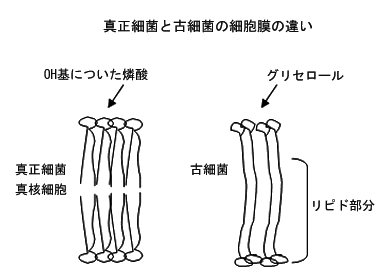
It seems that archaea were the first to live in the Hadean era 3.8 billion years ago.It belongs to a different lineage than eubacteria,present-day bacteria, and their ecological mechanisms and genes are completely different. Well-known examples are highly halophilic bacteria, methane bacteria , andthermophilic bacteria.Even today, these archaea are still alive.
We human beings are surrounded by archaea and eubacteria that have survived from ancient times to the present. Also, the virus and rickettcher are still alive.They will be our seniors as creatures of the earth.
Now, let's think about the cell membranes of living things.
| It is about the need for a resting membrane potential. |
When a large potential difference is created inside and outside the cell, it causes?very fast information transmission by using that potential difference.
For example, if the cell membrane were a dam, the water level difference would be a potential difference and the sluice would be an ion channel.
If the level difference (potential difference) is released by opening the water gate (ion channel) all at once, the large and quick driving force will be generated.
Here, I will explain about ion channel later.
What is necessary to generate a resting membrane potential?
The condition is that the distribution of ions inside and outside the cell is different.
Now how can we make a difference in the concentration of ions inside and outside the cell?
Moreover, this change occurs very close to the cell membrane, that is, 2 to 3 nm around the membrane.?
It doesn't mean ions in the entire cell change.
It is the change of ions at the very thin part of the cell membrane.
There are pumps and channels involved in the change of ions.
| Na K pump and K leak channel |
Let't see the figure below.?The yellow-green color is the Na K pump?, and the red color is the k leak channel?.
This NaK pump moves unusually.
I would like to explain about the cell membrane here.?●is phosphoric acid, which is hydrophilic, that is, a molecule mixed easily with water.
The part like beard comig out from phoshoric acid are the fatty acids,which is hydrophobic,that is,a molecule difficult to mix with water.?
The hydrophilic part is protruding into the fluid inside and outside the cells.The hydrophobic part is a fatty acid and is lined inside the cell membrane as shown below.
In other words,the?cell membrane is?made up?of lipids.
Ions, or charged substances, are immiscible with lipids,but uncharged molecules are miscible.
Cell membranes are like walls that are as hard as concrete for ions.?On the other hand, uncharged molecules pass through the cell membrane easily.
If the ions easily passed through the cell membrane, the ion concentration gradient would disappear and the resting membrane potential is not generated.

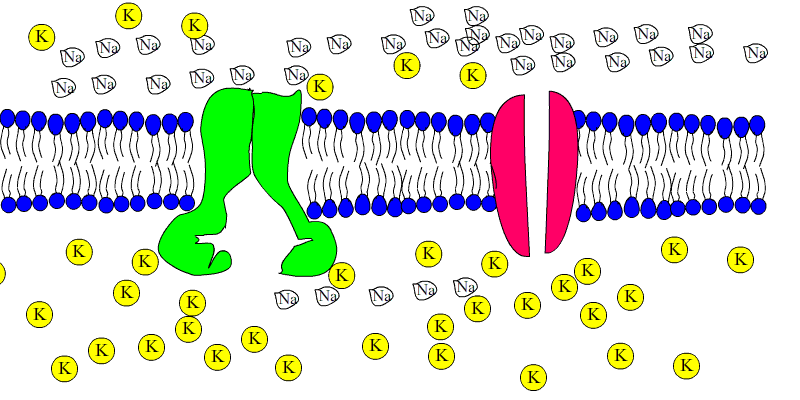
Na?ion outside the cell?>>>>the one inside the cells,K ion inside the cell?>>>>>?the one outside the cell.
In?this state, the?Na K pump?sends Na ions from inside the cell to the outside, and sends K ions from the outside to the inside.?Na ions and K ions are moved to high concentration areas.
Since there are 3 Na ions outside the cell and 2 K ions inside the cell, one cation inside the cell decreases.
Na is Na+ and represents a cation.
K is K + cation.
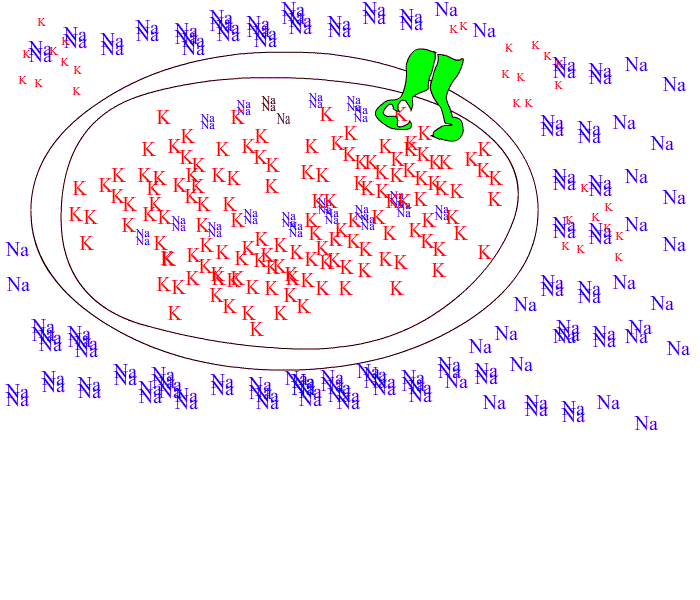
Extracellular
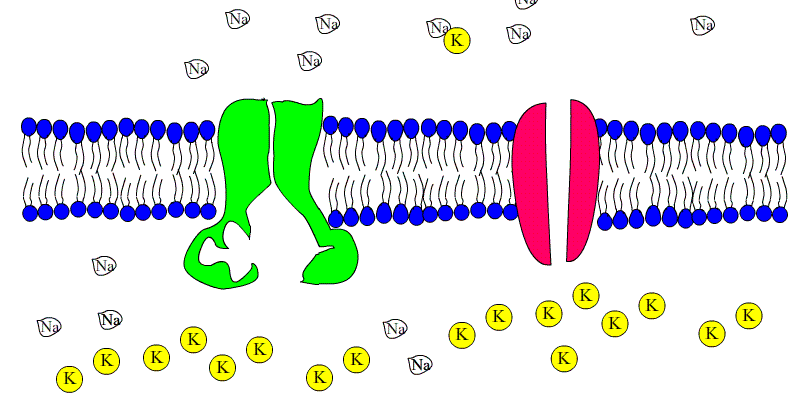
Intracellular
The energy to drive the NaK pump is ATP.?It?seems that?25~30% of?ATP consumed in one day is?used for this pump.
Next is?the k-leak channel.
Ion channel is a type of transmembrane protein in the biological membrane and is a generic term for proteins that passively permeate ions.?It not only maintains and changes the membrane potential of cells, but also carries out ion inflow and outflow in cells.
The K-leakage channel isexactly the channel that allows?K ions to flow.?Since the channel is always open, the hard-to-flow K ions also pass through the cell membrane.
Even if?K ions are pumped into?the?cells?with the NaK pump?,the K ions will leak out of the cells according to the concentration gradient?At this time, no energy is needed.?In other words, because the concentration of k ions inside the cell is high, it goes out of the cell where the concentration is low.
What happens when the K ions keep flowing out of the cell?
The K ion should go out of the cell until the concentration of K ion becomes the same inside and outside the cell, but in reality, at some point before that, the K ion stops going out.
Because K ions decrease inside the cell, the inside of the cell becomes electrically negative.
Then, the K ion, which is a cation, is electrically pulled in the negative cell, its movement is reduced, and it becomes hard to go outside the cell.
The action of K ions moving out by a concentration gradient (chemical gradient) and the action of keeping K ions (electrical gradient) determine whether K ions move.?The k ions do not move when they are balanced, and this state is called the equilibrium state. The potential generated at that time is the equilibrium potential, which is almost close to the resting membrane potential.
Negative potential is created by the negative inclination in the cell.?This is the resting membrane potential.
From the biological point of view, the above explanation of the generation of the resting membrane potential seems?to start from the first movement of the?Na K pump?.?From a physico-chemical point of view,?it is understood?that the K+ ion moves firstdue to the difference in membrane permeability and the concentration of K+ ion, and then the?Na K pump?moves.
For more information, please check the following URL
https://gozasso.com/kikkenlab/028-resting-membrane-potential/
How can we explain the existence of the resting membrane potential by?the movement of ions??
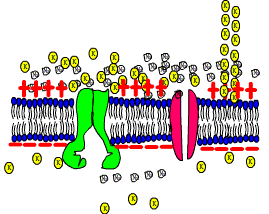
As in the left figure, you can see?− inside of the cell membrane?,+ outside it.?It means negative ions inside and positive ions outside.?When the + and-ions are separated from each other across the cell membrane, an electric potential is generated.?The inner anions are CL ion and chlorine ion.
?
?
?
Then why is it -70 mV?
In simple terms, K ions can freely move between the inside and outside of the cell in the leak channel, so the equilibrium potential of K ions is obtained as described above.
The formula is called Nernst's formula, E=RT/zF(ln[ion]o/[ion]i)
From this, the importance of K ion is derived.?It's a complicated story, so take a look at this site.?http://noucobi.com/neuro/neurophysiology/S1.html
| About action potential |
Excitation is synonymous with the fact that cells generate action potentials in physiology.?All living cells have a resting membrane potential, but many tissue cells that make up the body, such as hepatocytes and epithelial cells, do not generate action potentials.?On the other hand, nerve cells and muscle cells generate action potentials.?The action potential is a large transient transient potential change when the intracellular potential becomes smaller than a certain value.
Here we consider the generation of action potentials in nerve cells.
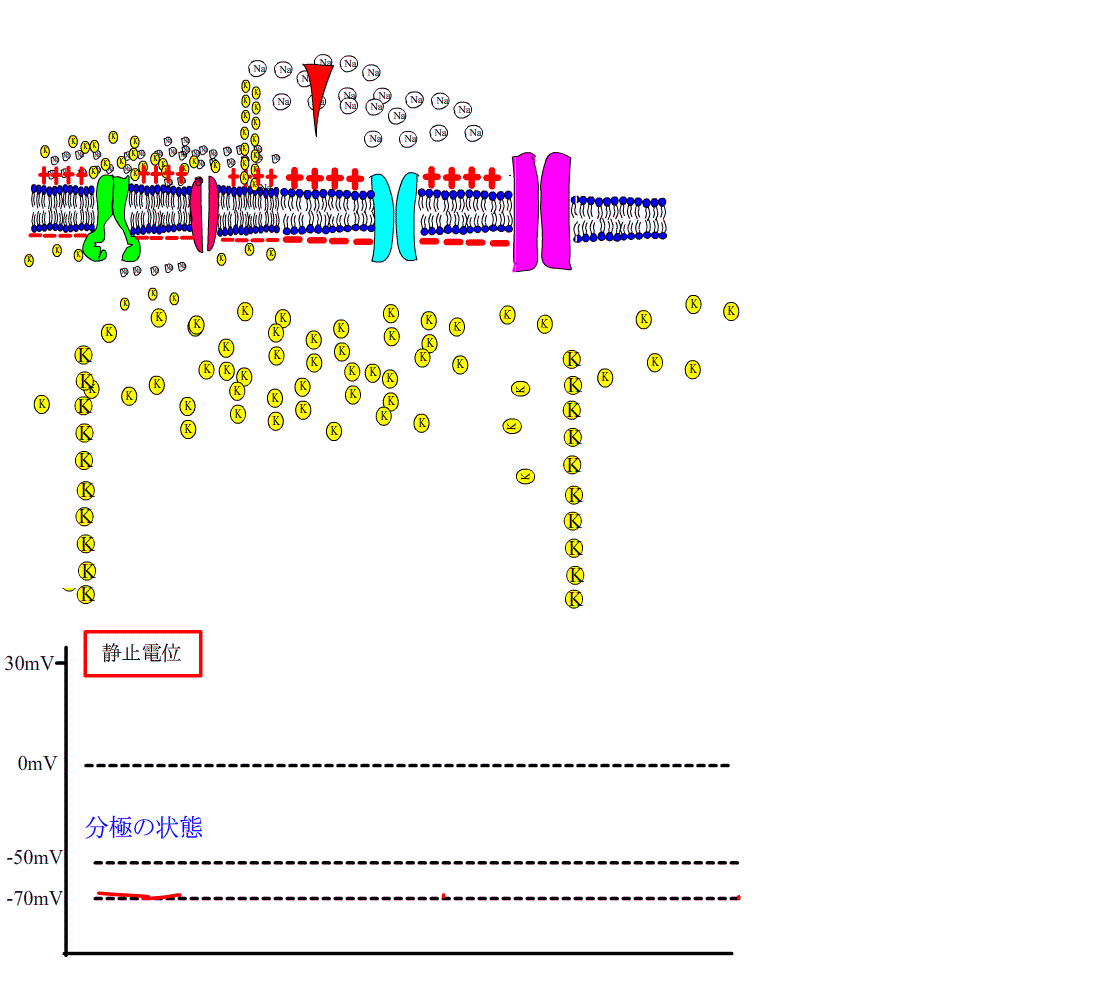
Stimulation
As shown in the animation above, in the cell membrane, certain stimulus is generated.?Then, the?voltage-gated Na channel![]() ?changes.
?changes.
The?voltage-gated Na channel ![]() ?shown in blue?opens?.?From outside the cell,?Na ions?flow into?the?cell?according to a concentration gradient and an electrical gradient?.
?shown in blue?opens?.?From outside the cell,?Na ions?flow into?the?cell?according to a concentration gradient and an electrical gradient?.
Depolarization
(Polarization is a state in which the inside of the cell is negative compared to the outside of the cell. Depolarization is the movement of changing this state.)
The influx of Na ions?decreases the negative of the ?membrane potential,?opens the?voltage-dependent Na channel  .Na ions inflow futher,and make inside?the?cell?positive ?.
.Na ions inflow futher,and make inside?the?cell?positive ?.
Na ions increase in within the cell more fequently than K ions decrease in migrating outside the cell through the K leaky channel, resulting in a positive potential.
Peak
As shown in the animation, when the membrane potential reaches +30 mV, that is, it peaks, the?voltage-sensitive Na channel closes, ending the influx of Na into the cell.
closes, ending the influx of Na into the cell.
Then, after a short delay, the?voltage-gated K channel opens.
opens.
Repolarization
The?opening?of voltage-gated K channels  causes?K ions to move out of the cell by the concentration and electrical gradients, reverse the membrane potential to negative, and generate repolarization??.
causes?K ions to move out of the cell by the concentration and electrical gradients, reverse the membrane potential to negative, and generate repolarization??.
Hyperpolarization
The timing at?which the voltage-gated K channel? ?closes cannot respond immediately to changes in the membrane potential.?Therefore, even after the membrane is sufficiently repolarized, K ion outflow continues, and the membrane potential becomes lower than the normal resting membrane potential.?This is called hyperpolarization.
?closes cannot respond immediately to changes in the membrane potential.?Therefore, even after the membrane is sufficiently repolarized, K ion outflow continues, and the membrane potential becomes lower than the normal resting membrane potential.?This is called hyperpolarization.

Next, we will talk about the conduction of action potentials through nerves. This story needs to be viewed as a space.

